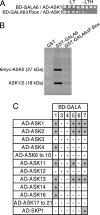Ralstonia solanacearum requires F-box-like domain-containing type III effectors to promote disease on several host plants
- PMID: 16983093
- PMCID: PMC1600009
- DOI: 10.1073/pnas.0509393103
Ralstonia solanacearum requires F-box-like domain-containing type III effectors to promote disease on several host plants
Abstract
The phytopathogenic bacterium Ralstonia solanacearum encodes a family of seven type III secretion system (T3SS) effectors that contain both a leucine-rich repeat and an F-box domain. This structure is reminiscent of a class of typical eukaryotic proteins called F-box proteins. The latter, together with Skp1 and Cullin1 subunits, constitute the SCF-type E3 ubiquitin ligase complex and control specific protein ubiquitinylation. In the eukaryotic cell, depending on the nature of the polyubiquitin chain, the ubiquitin-tagged proteins either see their properties modified or are doomed for degradation by the 26S proteasome. This pathway is essential to many developmental processes in plants, ranging from hormone signaling and flower development to stress responses. Here, we show that these previously undescribed T3SS effectors are putative bacterial F-box proteins capable of interacting with a subset of the 19 different Arabidopsis Skp1-like proteins like bona fide Arabidopsis F-box proteins. A R. solanacearum strain in which all of the seven GALA effector genes have been deleted or mutated was no longer pathogenic on Arabidopsis and less virulent on tomato. Furthermore, we found that GALA7 is a host-specificity factor, required for disease on Medicago truncatula plants. Our results indicate that the GALA T3SS effectors are essential to R. solanacearum to control disease. Because the F-box domain is essential to the virulence function of GALA7, we hypothesize that these effectors act by hijacking their host SCF-type E3 ubiquitin ligases to interfere with their host ubiquitin/proteasome pathway to promote disease.
Conflict of interest statement
The authors declare no conflict of interest.
Figures




References
-
- Genin S, Boucher C. Annu Rev Phytopathol. 2004;42:107–134. - PubMed
-
- Axtell MJ, Chisholm ST, Dahlbeck D, Staskawicz BJ. Mol Microbiol. 2003;49:1537–1546. - PubMed
-
- Alfano JR, Collmer A. Annu Rev Phytopathol. 2004;42:385–414. - PubMed
-
- Hotson A, Chosed R, Shu H, Orth K, Mudgett MB. Mol Microbiol. 2003;50:377–389. - PubMed
-
- Viboud GI, Bliska JB. Annu Rev Microbiol. 2005;59:69–89. - PubMed
Publication types
MeSH terms
Substances
Associated data
- Actions
- Actions
LinkOut - more resources
Full Text Sources
Other Literature Sources
Molecular Biology Databases

